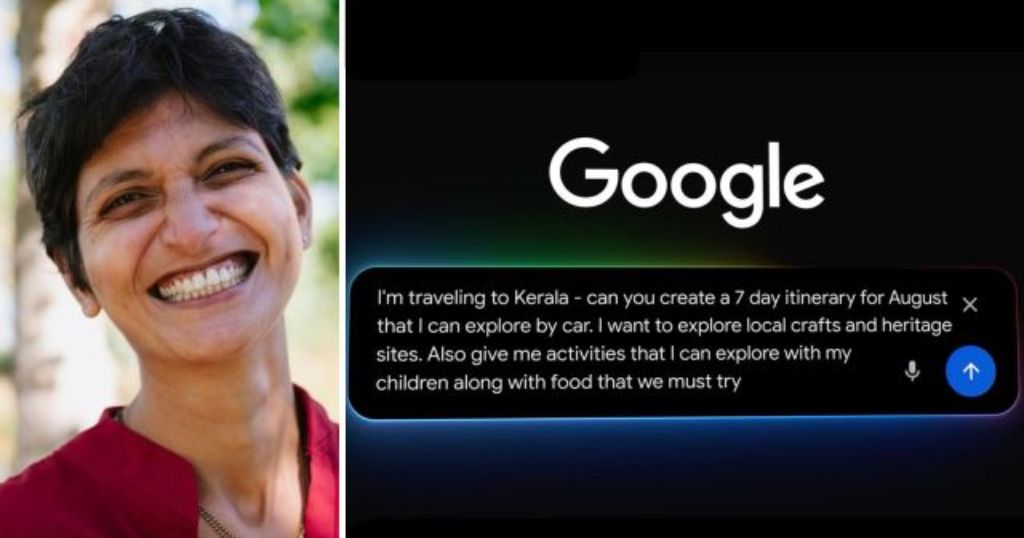AI Meets India: “Talk to AI Mode like you’re talking to a friend and say exactly what you mean,” said Hema Budaraju, Google’s Vice President of Product Management for Search. Google has now officially launched AI Mode in India, marking a big step forward in how we search online. First introduced in the US on June 25, this feature lets people ask questions in a natural, easy way — even if they’re long or complicated.
Budaraju called AI Mode Google’s “most powerful AI search”. The feature is now live for users in India — no sign-up needed. She also shared what this new experience means for the future of the search and what users can also expect.
Why India first?
Budaraju began by explaining how AI Mode in the Search works. When asked why India was chosen as the first international market, she said it’s because of how quickly Indian users adopt the new technology. “We are always excited about the bringing technology to India,” she said.
“I think Indian users really understand and accept new technology quickly — whether it’s AI Overviews, Google Lens, or multimodal maps,” said Budaraju. “They not only use these tools well but also help us improve them. So, for us, it’s a privilege to bring AI Mode to India as the first country outside the U.S.”
She explained that the decision to launch in India wasn’t random. Google’s data shows that Indian users are especially good at using features like multimodal search — where you can search with text, images, and voice together. In fact, India has also more monthly Google Lens users than any with other country. This made India the perfect place to launch and test AI Mode’s advanced features.
When asked about how Indian users have responded so far, Budaraju said the feedback during the Lab’s testing phase has been very positive. “People are really liking how fast the answers come, how good the quality is, and how up to date the content feels,” she shared.
She also mentioned that Indian users are asking more complex and detailed questions. “We’ve seen that people here are asking longer, open-ended questions. They want to explore deeper topics, get step-by-step instructions, compare products, and even use it for learning and education,” Budaraju explained.
A New Way to Search: Smarter, Longer, and More Helpful
AI Meets India: Google’s new AI Mode marks a big change in how people use search engines. Built on a custom version of Gemini 2.5, it’s designed to solve a common problem: some questions are just too hard or time-consuming to search the old way. “There are still questions and tasks that feel too hard,” said Budaraju, explaining Google’s goal of making search much easier and more helpful.
With AI Mode, users can also ask much longer and more complex questions than before. Budaraju shared that, “People are using AI Mode to ask questions that are two to three times of longer than regular searches,” showing a clear shift in how people search.
What makes AI Mode really stand out is its smart ‘fan-out’ technique. Budaraju explained that “AI Mode can break your question into smaller parts and search the web in many directions at once.” This allows it to dig deeper and return results that are more relevant and diverse — going beyond just surface-level answers.
This new approach changes search from a basic tool into something more like an intelligent assistant. It can understand complicated topics, give clear comparisons, and handle questions that used to take multiple searches or a lot of time to answer.
Focus on Quality and Safety
Since AI-generated responses can be complex, Google is putting extra focus on making sure they are accurate and safe. The company, known for its wide range of AI tools, continues to lead in developing responsible AI.
When asked how Google keeps AI Mode reliable, Budaraju said, “With every new feature we launch, quality is our top priority.” She explained that AI Mode is built on the same safety and quality systems that have been part of Google Search for over 20 years.
To make sure AI Mode is safe, Google also uses strict testing methods. This includes detailed internal checks, and something called “adversarial red teaming” — a process where testers try to break or confuse the system to find any weaknesses. This helps ensure the AI works well even in tough situations, without compromising safety.
What About Publishers and Content Creators?
With the rise of AI tools like AI Mode, many publishers and content creators have concerns about how this might affect their traffic and visibility on Google. Budaraju addressed this directly, saying that Google is still strongly committed to supporting the wider web ecosystem.
“Our main mission at Google is to connect people with information from across the web and from different points of view,” she said.
She explained that AI Mode’s “fan-out” technique — which breaks down questions into smaller parts and searches deeper — actually helps bring even more web content to the surface than before. “This approach allows us to explore the web more deeply than traditional search, which means we can highlight a much wider range of content. And that will also encourage people to ask newer and more interesting questions,” Budaraju added.

A Glimpse into the Future of Search
With AI Mode now available in India, users aren’t just getting a new feature — they’re experiencing the future of how we are interact with technology. Instead of typing short keywords, people can now simply ask questions in natural language and get information from all over the world, quickly and easily.
“Ask anything, any way you want, effortlessly, and find what you’re seeking,” Buda Raju said, summing up to the goal of AI Mode and how it’s designed to transform the way we search.
Also Read: Samsung Galaxy Z Flip 7 Leak Reveals Bold New Design Ahead of July 9 Launch










































